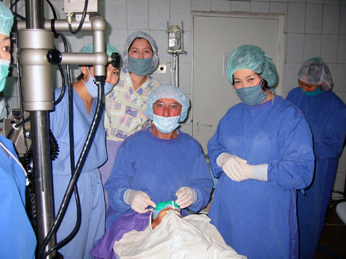
Missions 2004
The Altaï Vision project
This humanitarian project follows a meeting with a Mongolian student, Dastan Nigamet, during his studies at the MBA of Lyon, in 1999. He increased our awareness of the situation of the Mongolian nomadic population, more specifically in the Mongolian Altaï, after two harsh winters (Dzuud).
Two appraisal trips took place in 2001 and 2002. They both confirmed the lack of equipment and savoir-faire of the Mongolian healthcare system. Ophthalmological problems are among the most urgent and the easiest to make better in these rustic conditions of intervention.
1. Objectives
- Improve the ophthalmological service of Bayan Olgii’s hospital.
- Provide and install a proper set of equipment.
- Train the local ophthalmologist and share our savoir-faire. Nomadic lifestyle requires the development of regional medical centres. It is essential to reinforce the abilities of Byan Olgii’s hospital (located on the Westside of Mongolia) for the following reasons :
- High pathologic level (cataract, glaucoma) related to the harsh climatic conditions and to the altitude.
- Most of the patients (elder persons) can not physically or financially afford a journey to Ulaan Baatar (1600 km).
- The Kohvd centre crew (300 km) cannot provide these operations.
2. Area of action
Olgii, a city of 30 000 inhabitants, is the capital of Bayan Olgii area (Aimak). Olgii is located 1 650 km away from the Mongolian capital Ulaan Baatar. It can be reached by car (4 days on hard trails) or by plane 3 times a week. This area is located in the Altaï Mountains, surrounded by 4 000 metres peaks, near both Russian and Chinese borderlands. “Actions contre la faim”, which acts in Mongolia, selected this area to provide food.
3. Main points of this project
This project aims at 3 objectives:
- Provide required equipment for the Olgii hospital in order to purge cataract and glaucoma. (Meaning some diagnostics equipment, a microscope, etc).
- Training process for Mrs Gouliza, ophthalmologist at Olgii hospital, and sharing of French ophthalmologist René Fritsch’s savoir-faire.
- In addition, a few consultations will be made at the Ulaan Baatar’s “Hôpital de la charité” (hospital founded and looked-after by French nuns) and at the first university hospital managed by Mrs Lhagvadolgor.
4. Population aimed by this project
Aimag population totalised 100 000 people. The estimated number of persons who would benefit by this project is 100 (all the counties (sums) of aimag haven’t been visited by Mrs Gouliza yet). Among these people, children are suffering from congenital cataracts. The mid-term objective is to create a permanent ophthalmologic surgery unit at Olgii’s hospital to prevent main pathologies.
5. Requirements of this project
Your subscriptions will allow us to carry our project through by financing primary equipment and its transportation to Mongolia.
The preparatory mission
A first team composed of Claire Kopp and Alain Salmon went to Olgii in August 2004. This trip aimed at preparing the medical mission. Then, the microscope (550 lbs – 6.5 ft high) was delivered, assembled, and its working order was checked. In addition, the full package of medicine (100 cataract kits) was cleared through customs.
All administrative authorisations of doing surgical operations were accorded by local authorities. Finally, patients’ selection was initialised, via press and radio announcements. The first team was given the green light to start the medical mission.
The medical mission
The medical team is composed of Dr René Fritsch (ophthalmologist) and our local correspondent Dastan Nigamet. This team went for a 2 week trip to Olgii and a 1 week trip to Ulaan Baatar in September 2004. Dr Fritsch operated and formed Dr Gouliza – ophthalmologist – from Olgii’s hospital. 34 patients were on surgery (of whom 32 were affected by cataract).

In Ulaan Baatar, René Fritsch met Dr Lhagvadolgor – ophthalmologist – and he performed surgery in his presence. He also went to the hospital for mothers and children in order to operate a 1 year-old child of a double congenital cataract. Finally, Dr Fritsch inventoried and reported on state of places and equipment and drew a list of all requirements.

René is giving surgery to a baby affected of congenital cataract. Since then, Dr Gouliza operates on a few patients and uses the equipment we gave him.
